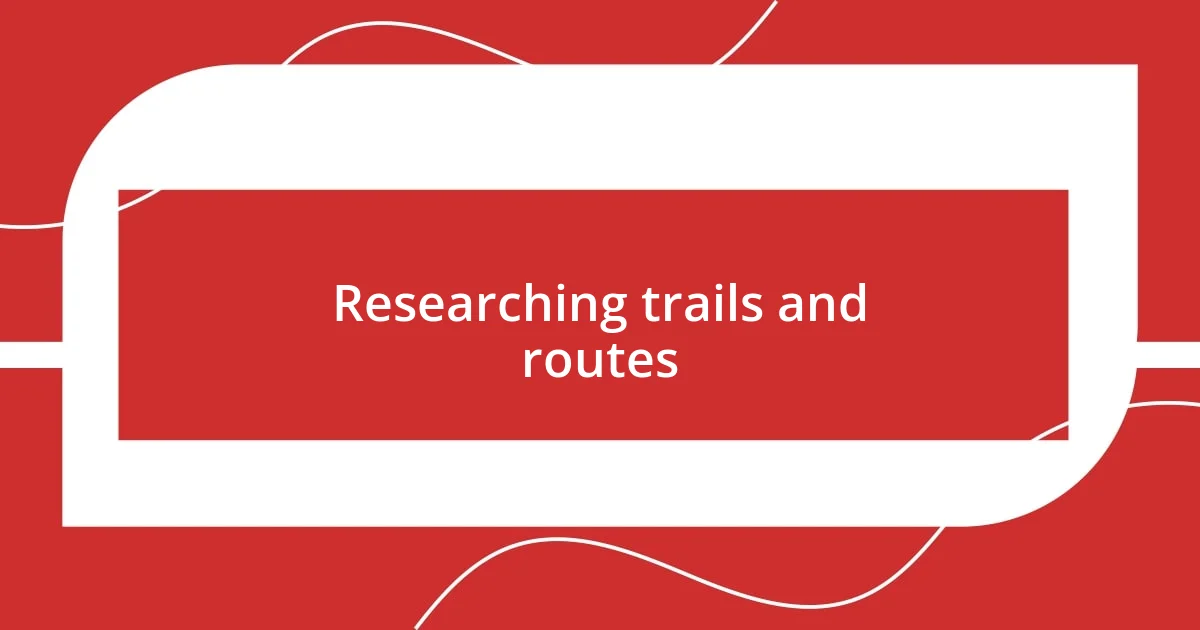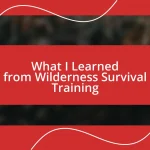Key takeaways:
- Choosing the right destination should align with personal interests and emotional connections, enhancing the overall experience.
- Thorough research on trails and routes, using apps and community insights, significantly contributes to a safe and enjoyable hiking experience.
- Reflecting on both the highs and lows of a trip enriches the backpacking journey, fostering growth and deeper appreciation for the adventure.

Choosing the right destination
When I began planning my epic backpacking trip, the first thing that struck me was the overwhelming number of destinations. It felt daunting, but I quickly realized that the right destination hinges on personal interests and experiences. What type of landscapes speak to you? For me, mountains have always called to my adventurous spirit, providing not just scenery but a sense of solitude and challenge.
As I narrowed down my choices, I asked myself what I wanted to gain from this journey. Was it cultural immersion or a thrilling outdoor escapade? I vividly remember standing in my kitchen, map sprawled out, trying to prioritize the experience: the vibrant streets of Kyoto or the majestic peaks of the Dolomites. The decision to go with the Dolomites ultimately resonated with my desire for exploration and adventure in nature.
Listening to my gut was crucial; I was drawn to places where I felt an emotional connection. It’s easy to get swayed by popular destinations, but I’ve found that picking someplace that resonates with who you are makes all the difference. Are you chasing stunning views, rich history, or perhaps a little bit of both? Trusting your instincts can truly lead you to a trip that ignites your passion for adventure.

Researching trails and routes
When diving into the research for my backpacking trip, I discovered that understanding trails and routes is just as critical as choosing the right destination. I often used apps like AllTrails or Gaia GPS, which provided detailed maps and user reviews. One trail I was particularly excited about had some stunning photos but reading a past hiker’s commentary made me reconsider. They highlighted challenging terrain that might not align with my current fitness level, reminding me that sometimes firsthand experiences can be a game-changer.
As I compared different potential routes, I couldn’t help but think of my last hike where I underestimated the length of the trail. I remember the exhaustion settling in as the sun began to set, coupled with the regret of not checking the estimated hike duration properly. This time, I’d jot down the trail distance, elevation gain, and tips from fellow hikers before finalizing my route. And let me tell you, this little pre-travel homework transformed my approach—taking an honest look at my capabilities led to a much more enjoyable adventure.
What’s more, exploring forums or community boards often reveals hidden gems that may not show up in mainstream guides. For instance, I stumbled upon a lesser-known trail in the Dolomites that offered breathtaking views without the crowds. Engaging in conversations with seasoned hikers online, or even local guides, unveiled insights that made a significant difference in how I perceived my trip. My journey became a collaboration between my journey and the wisdom of others, making it feel more enriching.
| Research Tool | Benefits |
|---|---|
| AllTrails | User reviews, detailed maps |
| Gaia GPS | Offline maps, tracking capabilities |
| Community Forums | Local insights, hidden gems |

Planning the itinerary and timeline
When it came to planning my itinerary and timeline, I found breaking it down into manageable segments was essential. I created a rough schedule to ensure I balanced trekking time with moments to soak in the surroundings. Like the first time I trekked through the mountains, I realized how easy it is to get caught up in the hustle—so this time, I committed to allowing time for nature’s beauty to unfold in front of me.
Here’s how I approached my itinerary planning:
- Daily Hiking Goals: I set realistic hiking goals based on my fitness level. No more than six hours of hiking a day!
- Rest Days: I included several rest days to explore nearby towns and recharge, which rejuvenated my spirit and added to my overall experience.
- Local Events and Festivals: I researched local events happening in the areas I’d visit to immerse myself in the culture, remembering how much joy it brings to witness local traditions firsthand.
- Weather Considerations: Keeping an eye on the weather forecast helped in adjusting plans for challenging sections, a lesson I learned after I was caught in an unexpected rainstorm during a past hike.
As I pieced everything together, I made sure to leave some flexibility in my schedule. This helped me avoid chain-scheduling every moment, which can often lead to burnout. I fondly recall a time when an impromptu chat with locals led me to a hidden waterfall—nothing beats spontaneity in adventure. Embracing that unexpected detour turned out to be one of the highlights of my trip, reminding me that sometimes the best experiences are the ones you don’t plan for.

Packing essential gear and supplies
Packing my essential gear and supplies was a whole adventure in itself. I learned the hard way that weight matters. On one trip, I packed what felt like everything but the kitchen sink, only to struggle with my heavy backpack. This time, I prioritized a lightweight tent, a compact sleeping bag, and a versatile cooking system. Each item had to earn its place in my pack, leading me to ask myself: “Is this essential, or can I live without it?”
I also made a checklist to avoid last-minute panic. When I forget my trusty headlamp on a previous hike, I realized how disorienting darkness could be in the wilderness. This time, my list included practical items like a first-aid kit, a fire starter, and extra food. I even packed a small journal to document my thoughts—after all, isn’t reflecting on our experiences just as vital as the adventure itself?
Lastly, I considered the seasons and terrain. Packing the right clothing can make or break the trip. I fondly recall a hike where I underestimated the cold and ended up wearing every piece of clothing I’d packed. Now, I carry breathable layers and a waterproof jacket, ensuring I’m ready for whatever Mother Nature throws my way. So, what’s in your gear bag? I can’t stress enough how every little choice contributes to your overall experience, adding to the joy—or discomfort—of each moment on the trail.

Preparing for safety and emergencies
Preparing for emergencies is a crucial aspect of any backpacking adventure. I remember a trip when, on the third day, I twisted my ankle. At that moment, having a well-stocked first-aid kit became a game changer. I made sure to pack essentials like antiseptic wipes, bandages, and pain relievers. More importantly, I learned to include a splint, which I didn’t think I’d ever need—until I did. Would I have blundered through if I hadn’t prepared? Possibly, but I was grateful for the peace of mind knowing I had support for minor injuries.
Another significant part of my emergency plan involved knowing how to communicate in remote areas. Cell service can be spotty, and once, during a solo trek, I found myself completely cut off. Thankfully, I had invested in a satellite messenger. This little gadget didn’t just ensure I could send an SOS if necessary; it connected me to family and friends, alleviating a lot of my anxiety. Yes, having a reliable way to reach out gives you options—and options in the wild mean safety.
Finally, I can’t stress the importance of letting someone know your plans. I made a habit of providing detailed itineraries to friends or family, including maps and expected checkpoints. On one occasion when I strayed off the chosen path, I felt confident knowing someone back home was aware of my route and could raise the alarm if I didn’t return on time. Setting up a safety net gives a sense of comfort, allowing you to focus on the adventure ahead instead of worrying about potential mishaps that, while unfortunate, can happen to anyone.

Tips for enjoying the journey
Finding joy in the journey is as essential as the destination itself. One of my favorite tips is to embrace spontaneity. On a particularly memorable trip, I stumbled upon a hidden waterfall that wasn’t on my map. I almost missed it because I was focused solely on my itinerary. I paused, listened to my instincts, and went exploring. That unexpected detour ended up being one of the highlights of my adventure. How often do we let rigid plans stifle our curiosity? Allow yourself to wander; you might discover something truly magical.
Another crucial aspect is connecting with nature. I’ve learned that simply stopping to enjoy my surroundings can transform my experience. There was a day when I felt overwhelmed by the miles I still needed to cover. So, I took a moment to sit beside a serene stream, let my feet dangle in the water, and breathe deeply. This little pause relieved my stress and helped me appreciate the beauty around me. Have you ever taken the time to notice the intricate details of your surroundings? I find those moments grounding and essential, enriching the overall adventure.
Finally, engaging with fellow hikers can enhance your journey immensely. I remember chatting with a couple at a campsite; their stories and advice changed my perspective about the trail ahead. Sharing laughter and experiences creates a sense of camaraderie. Don’t shy away from conversations with fellow adventurers, and who knows? You might just forge a friendship that lasts well beyond the trail. Isn’t it enriching when people come together over a shared love for nature? I certainly think so!

Reflecting on the trip experience
Reflecting on the trip experience brings a wave of mixed emotions. I often find myself reminiscing about the high points and the challenges that shaped my journey. Remember that moment at sunrise when I stood atop a mountain, feeling the chill air fill my lungs? It was a moment of pure bliss, a reminder that despite the blisters on my feet, I was exactly where I was meant to be. Those highs make every sore muscle worth it.
However, it’s essential to acknowledge the tough moments too. On another trip, I had to battle heavy rain, which tested my spirits. Rather than sulk, I turned my perspective around. I recall making a makeshift shelter from branches and enjoying hot soup by the fire, laughing at the situation. It taught me resilience and that sometimes, the struggles create the best stories. Have you ever turned a setback into a memorable experience? Those moments often shine the brightest in hindsight.
Ultimately, each trip is a tapestry woven with experiences, memories, and lessons. I’ve learned to be grateful for every aspect—good and bad—because they collectively enrich my love for backpacking. Reflecting on those moments allows me to grow, bringing a deeper appreciation each time I lace up my boots. Would I have gained this wisdom without the journey? Absolutely not—each experience brought me closer to understanding the beauty of imperfection.













